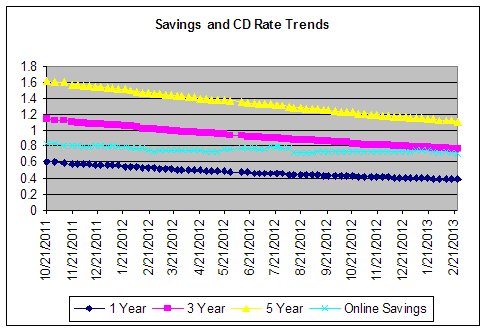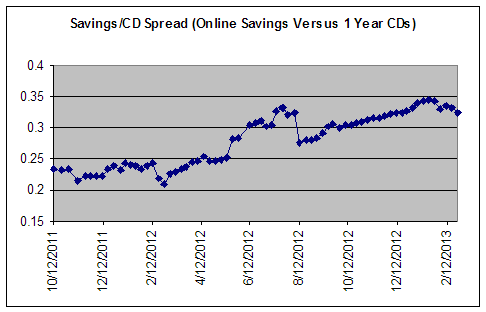Down, down, down. The trend in deposit rates, as expected, continues. All of the averages that BestCashCow tracks trended down over the past week. Average one-year CD Rates dipped from .389% to .387% APY. Three year average CD rates dropped from .769% to .765% APY. Five year average CDs dropped to from 1.119% to 1.115% APY. After staying stable for several months, online savings accounts dropped for the second week in a row from .720% to .712% APY.
Unlike the averages, the actual top rates remained steady over the past week.
- Online Savings: AmTrust Direct retained the top spot at 1.05% APY.
- 1 Year CD: Five banks retain the top spot at 1.05% APY.
- 3 Year CD: CIT Bank at 1.44% APY
- 5 Year CD: CIT Bank at 1.85% APY and Barclays Bank Delaware at 1.85% APY.
- Rewards Checking: Hope Credit Union - 3.51% APY rewards rate up to $10,000.
Local banks and credit unions often offer better rates (especially for CDs) than online banks so be sure to check them out. For example in Massachusetts, Belmont Savings Bank is offering a 1.15% APY savings account and First NBC Bank is offering a 2.27% APY 5 year CD (with a $100,000 minimum deposit). View local CD rates in your area.
The difference in the rate of decline between online savings and CD rates shows the spread still remains very elevated although it has come down in recent weeks as several online banks have cut rates. Salem Five Direct reduced their online savings rate last week and this week American Express reduced their online savings rate from .90% to .85% APY. On average, online savings account rates pay .325 percentage points more than 1 year CDs, up from .23 percentage points more at the beginning of last year but down from the spread's high of .344 percentage points in late January.
General rate environment
Sequestration is the word of the week as the economic news continues to be dominated by the machinations in Washington DC. For all the print, radio, and television time given to sequestration, it will not have a meaningful impact on bank deposit or lending rates. Should sequestration move forward, the cuts will total $85 billion for fiscal year 2013 out of an annual budget of about $4 trillion. That's a cut of approximately 2% of the Federal budget. The cuts represent about .05% of the $15.8 tillion U.S. economy. To put it into perspective, the Hurricane Sandy relief bill cost $50 billion in itself and there was no talk of financial doom and peril. By themselves, the numbers aren't as significant as the attention being give and, by themsleves, will have no impact on savings, cd, or mortgage rates.
The sequestration in combination with state and local spending cuts and tax increases will prove to be a drag on the economy and will be one factor that keeps rates low.
Looking overseas, Italians go to the ballet box to choose whether to continue their austerity program by electing Luigi Bersani, or chuck it overboard by choosing former Prime Minister Silvio Playboy Berlusconi. Europe's inability to find a fix for its fiscal problems has been a headwind to U.S. growth and has helped to keep rates low. As the third largest debtor in the world, and the largest in Europre, Italy's course will influence the other struggaling nations - Greece, Portual, Spain, Irelans - and play a key role in determining the fate of the Euro.
My outlook: Savings rates will continue to drift lower for the next 10-16 months before beginning to move higher. How high and how fast they move will depend on the government's ability to stop bickering and resolve their budget and borrowing disputes, the continuation of a recent economic uptick, technological advances, and the ability of Europe to put its woes behind it and resolve its fiscal problems.
My reasoning includes:
- The Fed has committed to keeping rates exceptionally low as long as unemployment is above 6 1/2 percent. It currently stands at 7.9%. At the current rate of decline, it will take at least 2-3 years to get to 7.9%. If the economy picks up, it could get there sooner.
- The economy has picked up a bit of steam in the last couple of quarters. But GDP growth of 1-2% will not be enough to quickly bring down the unemployment rate. I project steady but moderate economic growth of around 2.5% in 2013.
- Bank are awash in cash from individuals and corporations and do not need more deposit dollars. Third quarter 2012 FDIC data showed banks had over $9 trillion in deposits, up from $8.5 trillion in the third quarter of 2011. Many banks are having trouble figuring out how to deploy their cash. Part of this is because of lending fears and credit quality and the other part is due to increased governmental oversight.
- Demographic trends are unfavorable. Unfortunately, the United States has entered a demographic slide. As the large baby boom generation ages and retires, this puts a large strain on the country's productivity and spending. I believe that demographics is a general driver of economic development. A young population lifts all boats. An aging will leave quite a few boats stranded and make it difficult for the others. Japan and Europe have even worse demographic problems and their economies reflect that. As China's population ages, look for its growth to ebb. This demographic slide will be a factor for the next ten to twenty years, not stopping growth, but certainly acting as a headwind.
- Government grid-lock. The debt ceiling threat has been raised for now but sequestration still looms. It's clear that these battles will continue to occur anytime a budget decision is needed until one philosophy prevails. At this point, a bi-partisan solution looks unlikely. The partisan bickering does little to establish confidence.
- Local, state, and government cuts and tax increases are going to slow the economy. Government at all levels is cutting back and raising taxes. At this point, it looks doubtful that businesses and the consumer will be able to make up the difference (especially with rising taxes).
It all sounds pretty gloomy but I just have to believe that there is some positive event out there that will change the dynamics of the economy. Even as the economy languishes, progrss and technological innovation continues and eventually this progress will be felt.
Savings Accounts or CDs?
The data continues to show that opening a savings account is a better bet than a 1-3 year term CD and I expect this to hold through 2013. Online savings accounts have held the line over the past year while CD rates continue to fall. As the chart shows, the premium for opening a longer-term CD has eroded significantly and continuously over the past year. While the premium for opening a 5-year CD over a 1-year CD was 1 percentage point in October 2011, it now stands at .728 percentage points.
So for now, here are my recommendations on which deposit accounts to open:
For money you want to keep liquid, go with online savings accounts. They offer better rates than 1-3 year CDs and athough several banks have dropped rates in the past week, they have still offered decent rate stability over the past year.
If you want to take advantage of the higher rates on longer-term CDs, look to open them at local community banks. BestCashCow research has shown that community banks and credit unions offer the most competitive rates on longer-maturity CDs. Otherwise, you'd be better off keeping your money liquid in an online savings account.
I believe this is the best and easiest strategy for keeping your cash liquid and maximizing your savings over the next year.
Make the best of a tough savings situation in 2013
Yields may be low in 2013 but a savvy saver can boost the return with no increase in rate by rate shopping. By shopping around, a saver can earn an extra half to full percentage point. On $100,000, that's $1,000 in extra cash per year. Remember, even in today's environment, there is competition for your cash.


